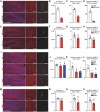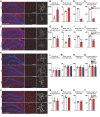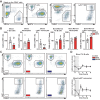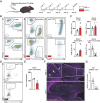Brain Resident Ly6Chi Monocytes Are Necessary for Maintaining Adult Hippocampal Neurogenesis
- PMID: 39656489
- PMCID: PMC12339147
- DOI: 10.14336/AD.2024.0835
Brain Resident Ly6Chi Monocytes Are Necessary for Maintaining Adult Hippocampal Neurogenesis
Abstract
Adult hippocampal neurogenesis (AHN) is crucial to various brain functions. Neurodegeneration, neuroinflammation and stress can impair AHN, contributing to the development of neurological and psychiatric disorders. Stress is known to extensively affect both the brain and peripheral immune system. However, the cellular and molecular mechanisms underlying stress-induced impairments in AHN remain unclear. In this study, we found that, unlike neuroinflammatory conditions, stress significantly inhibited AHN independently of microglial activation, suggesting a novel mechanism mediating stress-impaired AHN. Since stress modulates peripheral immune cells, we examined the distribution of immune cells infiltrating the brain. We found a significant decrease of infiltrated Ly6Chi monocytes in the brain parenchyma. In the blood, adoptively transferred ZsGreen+ Ly6Chi monocytes drastically reduced due to stress-induced homing to the bone marrow. Adrenalectomy (ADX) experiments revealed that monocyte homing is regulated by glucocorticoid and may cause impairments in AHN. Depleting peripheral circulating monocytes reduced brain-resident Ly6Chi monocytes and replicated the stress-induced inhibition of AHN, independent of microglia activation. RNA sequencing analysis of Ly6Chi monocytes revealed a stress-induced transcriptional profile, suggesting their supportive role in neuronal functions. Together, these findings demonstrate a novel and essential role of brain resident Ly6Chi monocytes in maintaining AHN at basal level, which is important for brain functions.
Figures








Similar articles
-
Short-Term Memory Impairment.2024 Jun 8. In: StatPearls [Internet]. Treasure Island (FL): StatPearls Publishing; 2025 Jan–. 2024 Jun 8. In: StatPearls [Internet]. Treasure Island (FL): StatPearls Publishing; 2025 Jan–. PMID: 31424720 Free Books & Documents.
-
Low-Intensity Physical Exercise is Associated with Improved Myelination and Reduced Microglial Activation in a Cuprizone-Induced Demyelination Model.Neurochem Res. 2025 Jun 5;50(3):182. doi: 10.1007/s11064-025-04441-8. Neurochem Res. 2025. PMID: 40471423 Free PMC article.
-
Gamma Oscillation Disruption Induced By Microglial Activation Contributes to Perioperative Neurocognitive Disorders in Aged Mice.J Mol Neurosci. 2025 Aug 2;75(3):97. doi: 10.1007/s12031-025-02380-1. J Mol Neurosci. 2025. PMID: 40753364
-
The Black Book of Psychotropic Dosing and Monitoring.Psychopharmacol Bull. 2024 Jul 8;54(3):8-59. Psychopharmacol Bull. 2024. PMID: 38993656 Free PMC article. Review.
-
CX3CL1 Pathway as a Molecular Target for Treatment Strategies in Alzheimer's Disease.Int J Mol Sci. 2023 May 4;24(9):8230. doi: 10.3390/ijms24098230. Int J Mol Sci. 2023. PMID: 37175935 Free PMC article. Review.
References
MeSH terms
Substances
LinkOut - more resources
Full Text Sources
Medical
